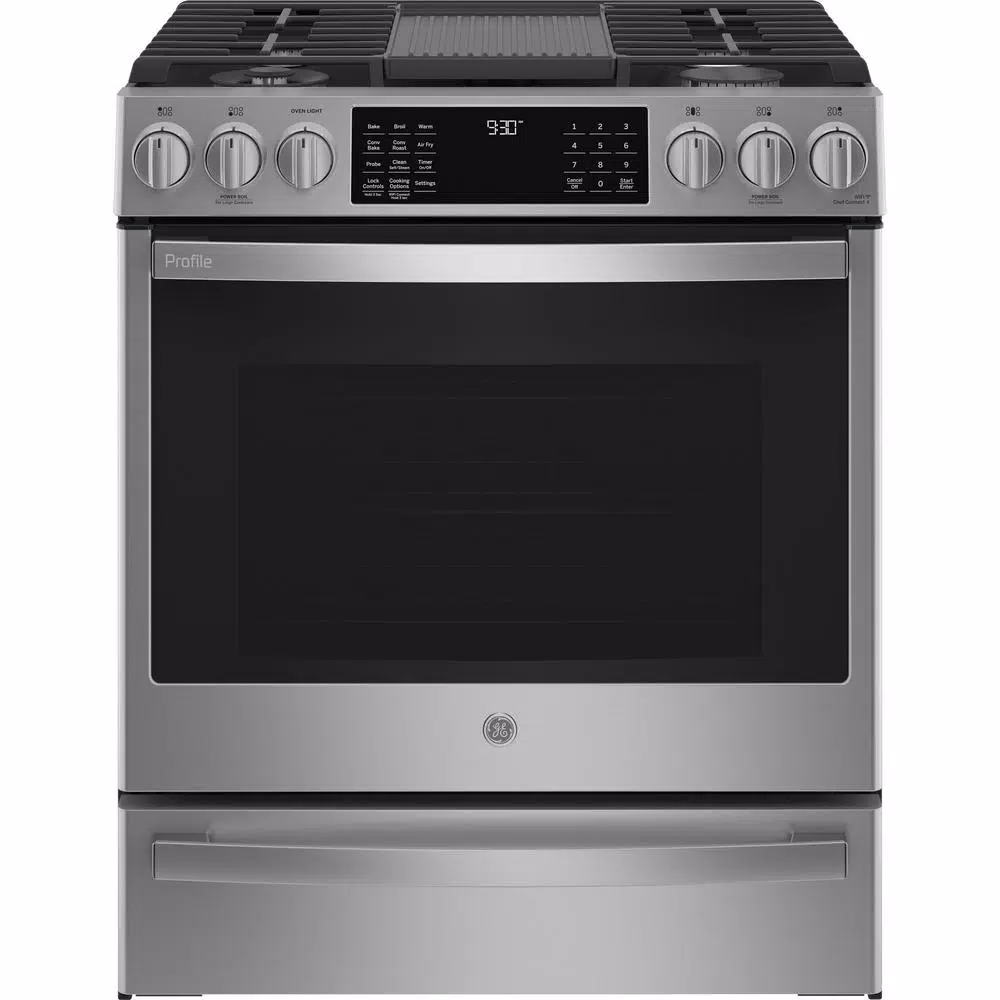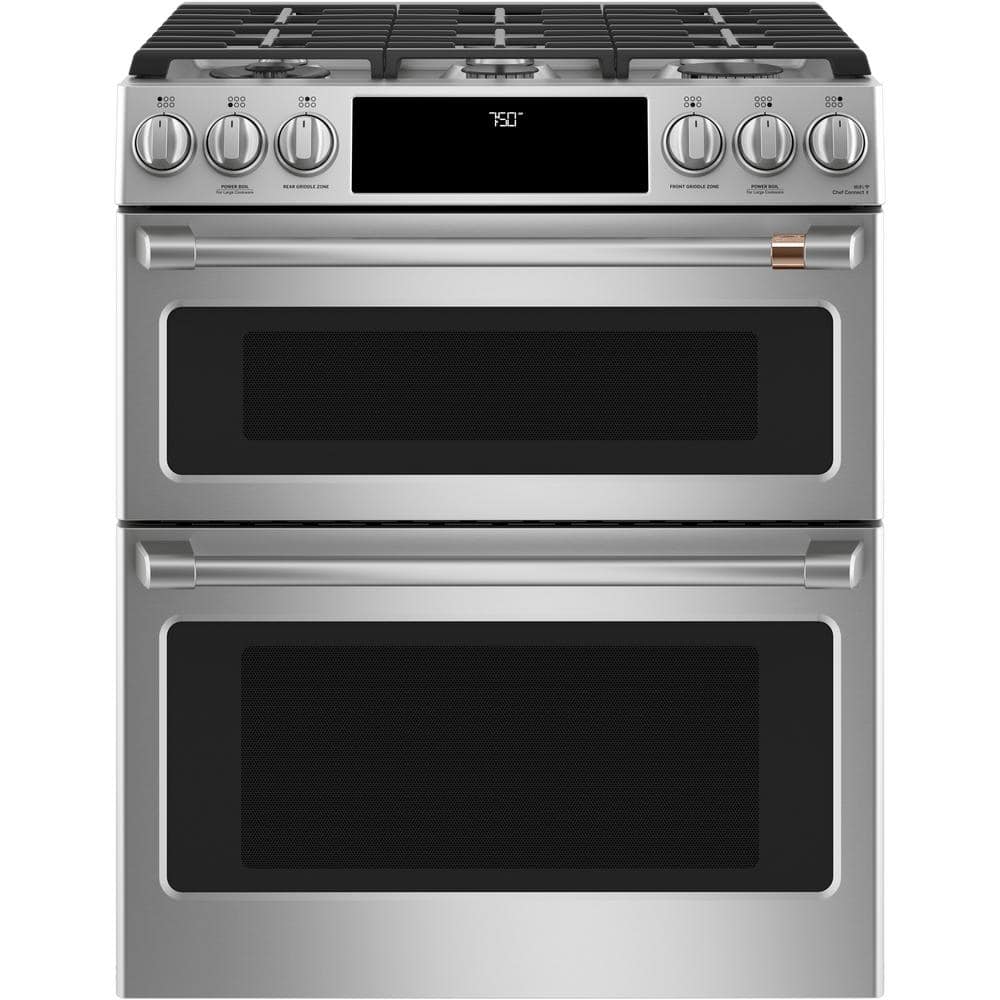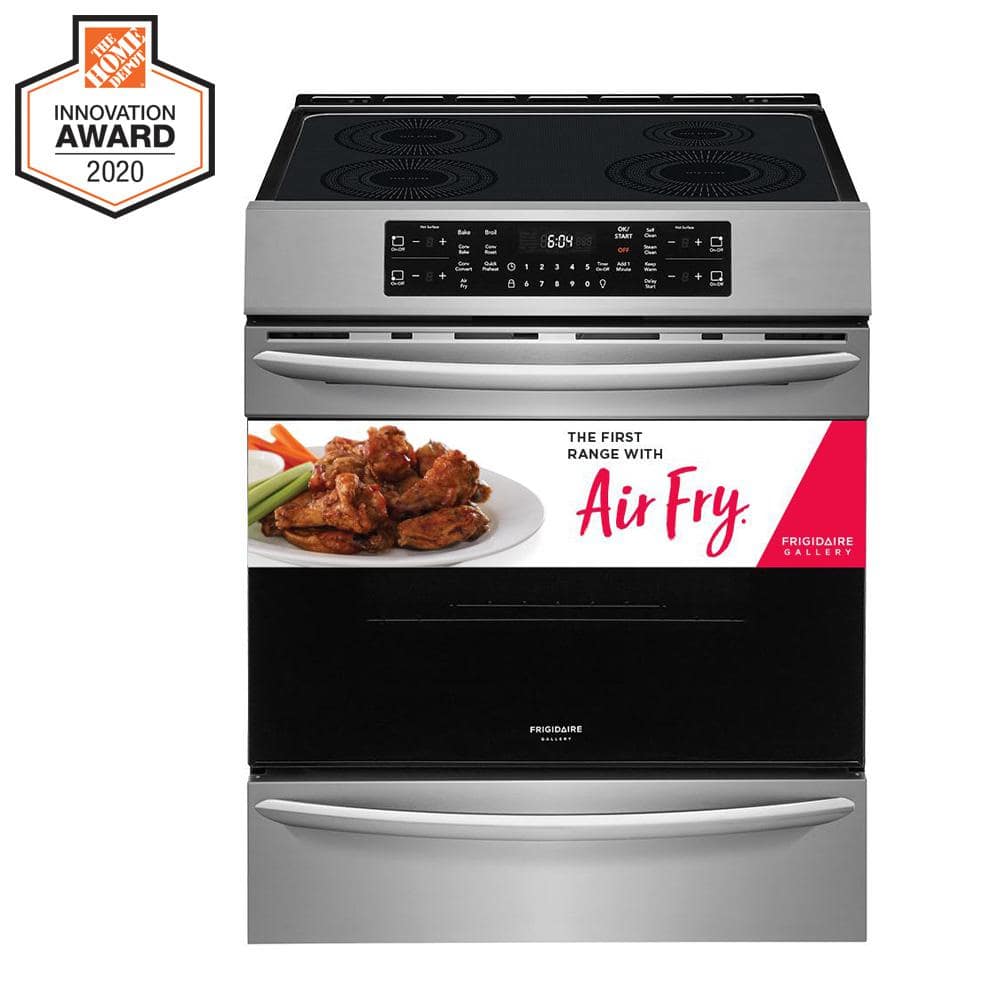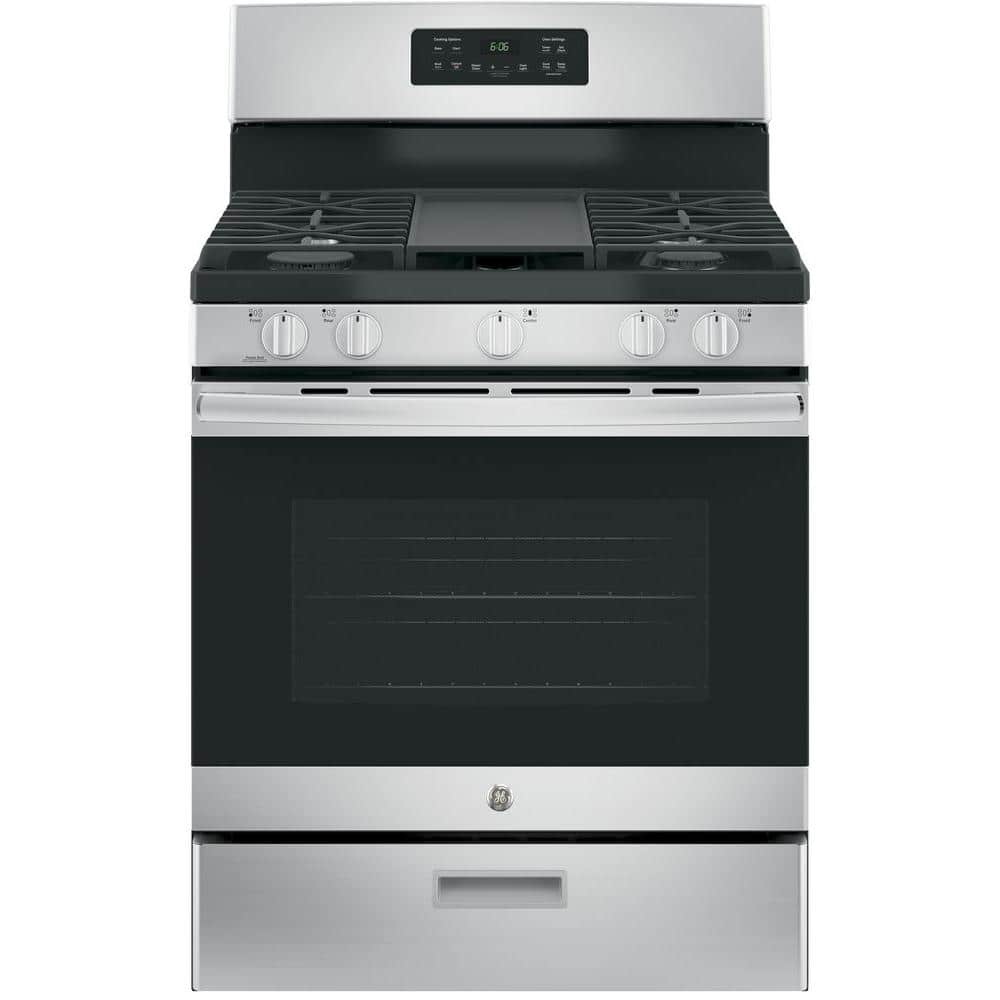LG 6.9 cu. ft. Double Oven Gas Range with ProBake Convection Oven, Self Clean and EasyClean in Stainless Steel
Large capacity oven & ProBake Convection for even baking results. 5 burner stove top provides cooking and warming flexibility. EasyClean cleans your oven in 10 minutes with minimal effort.
The huge, 6.9 cu. ft. combined capacity gives you the freedom to create the ultimate meal, cooking multiple dishes at different temperatures. And never mind babysitting or rotating pans-LG ProBake Convection ensures no dish gets left behind with even cooking on every rack, every time. This range’s pro-style looks are easy to maintain with 10-minute EasyClean Express, so you can spend more time enjoying meals, less time scrubbing.
- Inspired by pro-style ranges, it’s the first freestanding range for the home to move the heating element from the bottom of the oven to the back wall for optimal heat distribution
- Simplify dinnertime with LG’s 6.9 cu. ft. double oven offering the largest capacity available
- Sleek, angled controls put power and visibility at your fingertips while bringing an updated, stylish look to your kitchen
- In three easy steps and 10 quick minutes your oven can be sparkling clean, without strong chemical fumes or high heat
- LG UltraHeat 18,500 BTU burners deliver every bit of the precision you love about gas with even more power
- These easy to clean burners provide flexible cooking power from 5,000 BTUs to 18,500 BTUs
- Intuitive SmoothTouch glass controls easily wipes clean and not only look sleek, but makes operating your range a snap with just a touch of your finger
- The Brilliant Blue Interior provides an upscale look with premium interior design
- Supersized window allows you to easily check the progress of a meal no matter where it’s placed in the oven
- The capacity, flexibility and performance for your biggest meals available in this LG Double Oven
- Other features include a clock, timer, and interior oven light
- EasyClean enamel technology provides two cleaning options for the inside of the range; the EasyClean feature helps lift soils without harsh chemicals, and it runs using ONLY WATER for just 10 minutes or 20 minutes in low temperatures to help loosen LIGHT soils before hand-cleaning
- While EasyClean is quick and effective for small and LIGHT soils, the Self Clean feature can be used to remove HEAVY, built up soils
- Offers versatile cooking settings with and without convection
- Installation is not available in all locations. See store for details.
Additional information
| Depth With Door(s) Open 90 Degrees (In.) | 40.93 |
|---|---|
| Lower Oven Interior Depth x Height x Width (in) | 20 x 14.25 x 24.81 |
| Product Depth x Height x Width (in) | 28.94 x 47.31 x 29.88 |
| Range Size | 30 in. |
| Upper Oven Interior Depth x Height x Width (in) | 20 x 9.25 x 24.8125 |
| Certifications and Listings | CSA Listed |
| Manufacturer Warranty | 1 year parts and labor |
6 (six) is the natural number following 5 and preceding 7. It is a composite number and the smallest perfect number.
Clean may refer to:
- Cleaning, the process of removing unwanted substances, such as dirt, infectious agents, and other impurities, from an object or environment
- Cleanliness, the state of being clean and free from dirt
Convection is single or multiphase fluid flow that occurs spontaneously due to the combined effects of material property heterogeneity and body forces on a fluid, most commonly density and gravity (see buoyancy). When the cause of the convection is unspecified, convection due to the effects of thermal expansion and buoyancy can be assumed. Convection may also take place in soft solids or mixtures where particles can flow.
Convective flow may be transient (such as when a multiphase mixture of oil and water separates) or steady state (see Convection cell). The convection may be due to gravitational, electromagnetic or fictitious body forces. Heat transfer by natural convection plays a role in the structure of Earth's atmosphere, its oceans, and its mantle. Discrete convective cells in the atmosphere can be identified by clouds, with stronger convection resulting in thunderstorms. Natural convection also plays a role in stellar physics. Convection is often categorised or described by the main effect causing the convective flow; for example, thermal convection.
Convection cannot take place in most solids because neither bulk current flows nor significant diffusion of matter can take place. Granular convection is a similar phenomenon in granular material instead of fluids. Advection is fluid motion created by velocity instead of thermal gradients. Convective heat transfer is the intentional use of convection as a method for heat transfer. Convection is a process in which heat is carried from place to place by the bulk movement of a fluid and gases.
Gas is one of the four fundamental states of matter. The others are solid, liquid, and plasma. A pure gas may be made up of individual atoms (e.g. a noble gas like neon), elemental molecules made from one type of atom (e.g. oxygen), or compound molecules made from a variety of atoms (e.g. carbon dioxide). A gas mixture, such as air, contains a variety of pure gases. What distinguishes gases from liquids and solids is the vast separation of the individual gas particles. This separation usually makes a colorless gas invisible to the human observer.
The gaseous state of matter occurs between the liquid and plasma states, the latter of which provides the upper-temperature boundary for gases. Bounding the lower end of the temperature scale lie degenerative quantum gases which are gaining increasing attention. High-density atomic gases super-cooled to very low temperatures are classified by their statistical behavior as either Bose gases or Fermi gases. For a comprehensive listing of these exotic states of matter, see list of states of matter.
LG Corporation (or LG Group), formerly known as Lucky-Goldstar, is a South Korean multinational conglomerate founded by Koo In-hwoi and managed by successive generations of his family. It is the fourth-largest chaebol (family-run conglomerate) in South Korea. Its headquarters are in the LG Twin Towers building in Yeouido-dong, Yeongdeungpo District, Seoul. LG makes electronics, chemicals, household appliances, and telecommunications products and operates subsidiaries such as LG Electronics, Zenith, LG Display, LG Uplus, LG Innotek, LG Chem, and LG Energy Solution in over 80 countries.
An oven is a tool which is used to expose materials to a hot environment. Ovens contain a hollow chamber and provide a means of heating the chamber in a controlled way. In use since antiquity, they have been used to accomplish a wide variety of tasks requiring controlled heating. Because they are used for a variety of purposes, there are many different types of ovens. These types differ depending on their intended purpose and based upon how they generate heat.
Ovens are often used for cooking, where they can be used to heat food to a desired temperature. Ovens are also used in the manufacturing of ceramics and pottery; these ovens are sometimes referred to as kilns. Metallurgical furnaces are ovens used in the manufacturing of metals, while glass furnaces are ovens used to produce glass.
There are many methods by which different types of ovens produce heat. Some ovens heat materials using the combustion of a fuel, such as wood, coal, or natural gas, while many employ electricity. Microwave ovens heat materials by exposing them to microwave radiation while electric ovens and electric furnaces heat materials using resistive heating. Some ovens use forced convection, the movement of gases inside the heating chamber, to enhance the heating process, or, in some cases, to change the properties of the material being heated, such as in the Bessemer method of steel production.
In philosophy, the self is an individual's own being, knowledge, and values, and the relationship between these attributes.
The first-person perspective distinguishes selfhood from personal identity. Whereas "identity" is (literally) sameness and may involve categorization and labeling, selfhood implies a first-person perspective and suggests potential uniqueness. Conversely, "person" is used as a third-person reference. Personal identity can be impaired in late-stage Alzheimer's disease and in other neurodegenerative diseases. Finally, the self is distinguishable from "others". Including the distinction between sameness and otherness, the self versus other is a research topic in contemporary philosophy and contemporary phenomenology (see also psychological phenomenology), psychology, psychiatry, neurology, and neuroscience.
Although subjective experience is central to selfhood, the privacy of this experience is only one of many problems in the philosophy of self and scientific study of consciousness.
Stainless may refer to:
- Cleanliness, or the quality of being clean
- Stainless steel, a corrosion-resistant metal alloy
- Stainless Games, a British video game developer
- Stainless Broadcasting Company, a TV broadcaster based in Michigan, US
- Stainless Banner, the second national flag of the Confederate States of America
Steel is an alloy of iron and carbon with improved strength and fracture resistance compared to other forms of iron. Because of its high tensile strength and low cost, steel is one of the most commonly manufactured materials in the world. Steel is used in buildings, as concrete reinforcing rods, in bridges, infrastructure, tools, ships, trains, cars, bicycles, machines, electrical appliances, furniture, and weapons.
Iron is always the main element in steel, but many other elements may be present or added. Stainless steels, which are resistant to corrosion and oxidation, typically need an additional 11% chromium.
Iron is the base metal of steel. Depending on the temperature, it can take two crystalline forms (allotropic forms): body-centred cubic and face-centred cubic. The interaction of the allotropes of iron with the alloying elements, primarily carbon, gives steel and cast iron their range of unique properties. In pure iron, the crystal structure has relatively little resistance to the iron atoms slipping past one another, and so pure iron is quite ductile, or soft and easily formed. In steel, small amounts of carbon, other elements, and inclusions within the iron act as hardening agents that prevent the movement of dislocations.
The carbon in typical steel alloys may contribute up to 2.14% of its weight. Varying the amount of carbon and many other alloying elements, as well as controlling their chemical and physical makeup in the final steel (either as solute elements, or as precipitated phases), impedes the movement of the dislocations that make pure iron ductile, and thus controls and enhances its qualities. These qualities include the hardness, quenching behaviour, need for annealing, tempering behaviour, yield strength, and tensile strength of the resulting steel. The increase in steel's strength compared to pure iron is possible only by reducing iron's ductility.
Steel was produced in bloomery furnaces for thousands of years, but its large-scale, industrial use began only after more efficient production methods were devised in the 17th century, with the introduction of the blast furnace and production of crucible steel. This was followed by the Bessemer process in England in the mid-19th century, and then by the open-hearth furnace. With the invention of the Bessemer process, a new era of mass-produced steel began. Mild steel replaced wrought iron. The German states were the major steel producers in Europe in the 19th century. American steel production was centered in Pittsburgh, Bethlehem, Pennsylvania, and Cleveland until the late 20th century.
Further refinements in the process, such as basic oxygen steelmaking (BOS), largely replaced earlier methods by further lowering the cost of production and increasing the quality of the final product. Today more than 1.6 billion tons of steel is produced annually. Modern steel is generally identified by various grades defined by assorted standards organizations. The modern steel industry is one of the largest manufacturing industries in the world, but also one of the most energy and greenhouse gas emission intense industries, contributing 8% of global emissions. However, steel is also very reusable: it is one of the world's most-recycled materials, with a recycling rate of over 60% globally.
With or WITH may refer to:
- With, a preposition in English
- Carl Johannes With (1877–1923), Danish doctor and arachnologist
- With (character), a character in D. N. Angel
- With (novel), a novel by Donald Harrington
- With (album), a 2014 album by TVXQ
- With (EP), a 2021 EP by Nam Woo-hyun






by Vablu
Delivery was flawless installed myself Wife loves the functions
by Donna
This is a great range! I’ve just downsized my house and went from two full size ovens And separate gas cooktop to this range and I love it! There’s obviously not as much room as I had with 2 full size ovens but I had plenty of room for holiday needs.
by Chris
Great double oven! I use it daily!